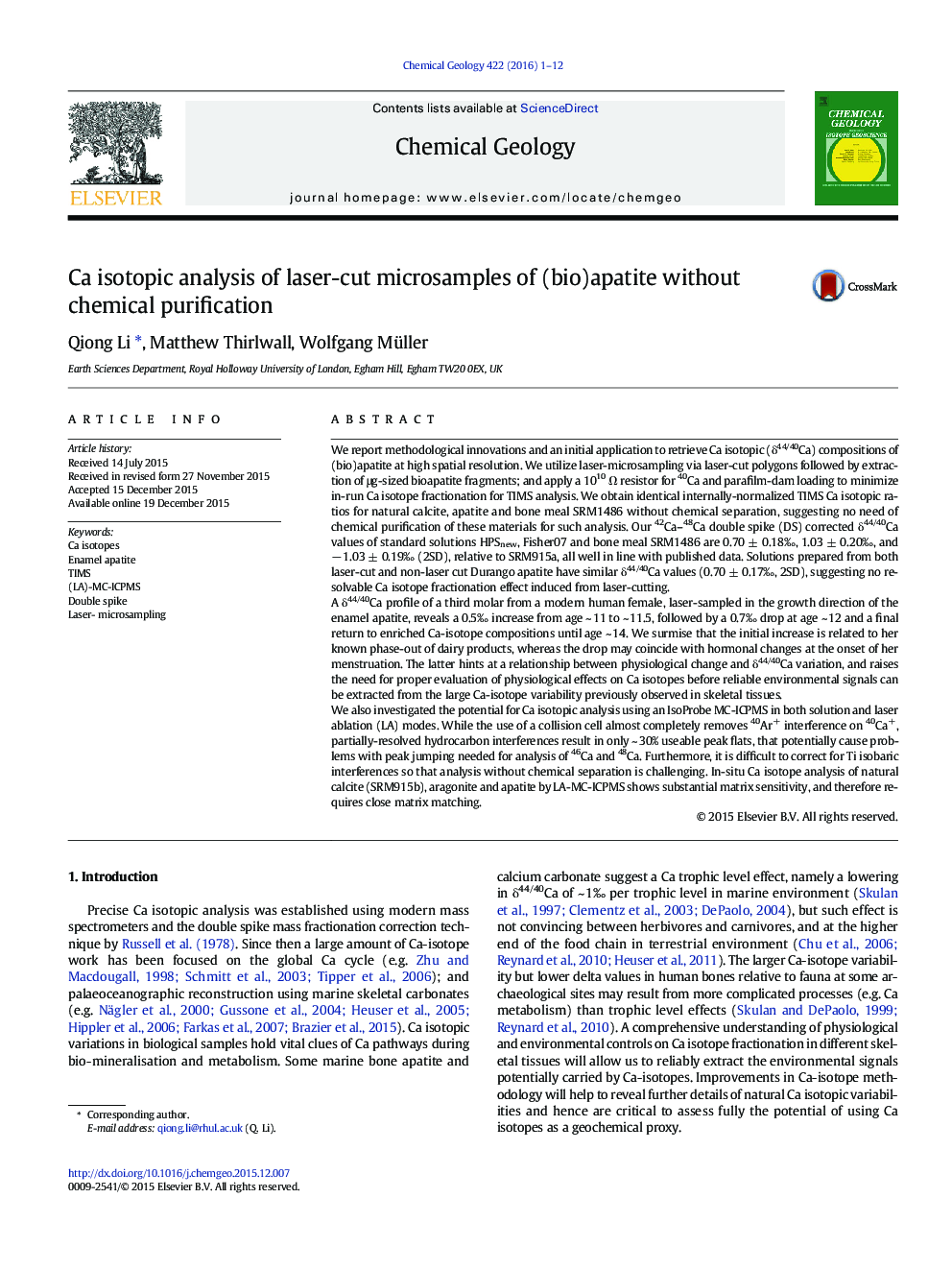| کد مقاله | کد نشریه | سال انتشار | مقاله انگلیسی | نسخه تمام متن |
|---|---|---|---|---|
| 4698372 | 1637552 | 2016 | 12 صفحه PDF | دانلود رایگان |

• Laser-cutting allows well-constrained microsampling along isochronous growth lines and extraction of μg-sized fragments.
• No ion exchange chromatography is required for accurate TIMS Ca-isotope analysis of natural calcite and (bio)apatite.
• The 42Ca–48Ca double spike corrected TIMS δ44/40Ca values of Ca-isotope standards agree well with published data.
• No detectable laser-induced mass fractionation on Ca isotopes is observed on apatite during laser cutting.
• The δ44/40Ca profile of a modern human third molar suggests both dietary and physiological controls on enamel Ca-isotopes.
We report methodological innovations and an initial application to retrieve Ca isotopic (δ44/40Ca) compositions of (bio)apatite at high spatial resolution. We utilize laser-microsampling via laser-cut polygons followed by extraction of μg-sized bioapatite fragments; and apply a 1010 Ω resistor for 40Ca and parafilm-dam loading to minimize in-run Ca isotope fractionation for TIMS analysis. We obtain identical internally-normalized TIMS Ca isotopic ratios for natural calcite, apatite and bone meal SRM1486 without chemical separation, suggesting no need of chemical purification of these materials for such analysis. Our 42Ca–48Ca double spike (DS) corrected δ44/40Ca values of standard solutions HPSnew, Fisher07 and bone meal SRM1486 are 0.70 ± 0.18‰, 1.03 ± 0.20‰, and − 1.03 ± 0.19‰ (2SD), relative to SRM915a, all well in line with published data. Solutions prepared from both laser-cut and non-laser cut Durango apatite have similar δ44/40Ca values (0.70 ± 0.17‰, 2SD), suggesting no resolvable Ca isotope fractionation effect induced from laser-cutting.A δ44/40Ca profile of a third molar from a modern human female, laser-sampled in the growth direction of the enamel apatite, reveals a 0.5‰ increase from age ~ 11 to ~ 11.5, followed by a 0.7‰ drop at age ~ 12 and a final return to enriched Ca-isotope compositions until age ~ 14. We surmise that the initial increase is related to her known phase-out of dairy products, whereas the drop may coincide with hormonal changes at the onset of her menstruation. The latter hints at a relationship between physiological change and δ44/40Ca variation, and raises the need for proper evaluation of physiological effects on Ca isotopes before reliable environmental signals can be extracted from the large Ca-isotope variability previously observed in skeletal tissues.We also investigated the potential for Ca isotopic analysis using an IsoProbe MC-ICPMS in both solution and laser ablation (LA) modes. While the use of a collision cell almost completely removes 40Ar+ interference on 40Ca+, partially-resolved hydrocarbon interferences result in only ~ 30% useable peak flats, that potentially cause problems with peak jumping needed for analysis of 46Ca and 48Ca. Furthermore, it is difficult to correct for Ti isobaric interferences so that analysis without chemical separation is challenging. In-situ Ca isotope analysis of natural calcite (SRM915b), aragonite and apatite by LA-MC-ICPMS shows substantial matrix sensitivity, and therefore requires close matrix matching.
Journal: Chemical Geology - Volume 422, 1 March 2016, Pages 1–12